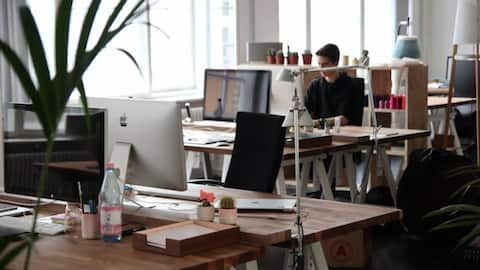Office peacocking: Luring remote workers back
What's the story
"Office peacocking," a trend that gained traction in 2024, involves transforming office spaces to entice employees back to work post-pandemic amidst the shift to remote work models. The makeover includes renovating workspaces with plush sofas, cozy corners, natural light, and plants, creating vibrant, lounge-style settings. Trendy decor and fancy amenities further make the office environment more appealing and comfortable, making workplaces more inviting.
Return-to-work
Measures taken amidst employee resistance
According to Frank Weishaupt, CEO of Owl Labs, these measures have been implemented by major companies following pushback from employees after the return-to-office (RTO) mandates. "The fourth anniversary of the pandemic has just been passed, and attempts to return to pre-pandemic policies are still being pursued by many employers," as conveyed by Weishaupt in his interview with Forbes.
Hybrid work
Employee preferences and workplace dynamics
It was stated by him that data indicates many employees are willing to make the sacrifice of pay for workplace flexibility, with 62% expressing willingness to accept a pay cut of 10% or more to sustain a hybrid work model. Additionally, Weishaupt noted that employees are seeking avenues to avoid the artificial pressures of "office peacocking."
Visibility
Why do businesses embrace office peacocking?
Businesses entice employees to choose to work on-site to increase their visibility to superiors. By being physically present, they aim to showcase their dedication and professionalism, similar to a peacock displaying its feathers. This strategy is believed to enhance their chances for recognition, collaboration opportunities, and career advancement, based on the notion that being out of sight could lead to being overlooked.
Human connections
Boost productivity and creativity
Companies embracing office peacocking prioritize employee well-being and human connections by investing in wellness programs, fostering team bonding, and enhancing workplace comfort. This strategic approach not only meets modern workforce expectations but also effectively entices employees back on-site, aligning with contemporary demands for a more employee-centric workplace and a supportive, engaging organizational culture that promotes productivity and satisfaction.
Retaining talent
Building a competitive advantage
A dynamic and appealing office environment plays a pivotal role in attracting new talent and retaining current employees, especially in competitive job markets. It serves as a compelling factor that influences individuals' decisions to join or remain with a company. By offering an engaging workplace, organizations demonstrate their commitment to a positive work culture that promotes long-term retention strategies in today's competitive employment landscape.
